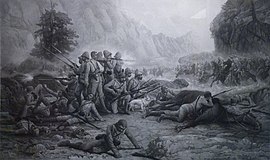Battle of Maiwand: Difference between revisions
Adarshatva (talk | contribs) No edit summary Tags: Mobile edit Mobile web edit Advanced mobile edit |
Adarshatva (talk | contribs) No edit summary Tags: Mobile edit Mobile web edit Advanced mobile edit |
||
| Line 33: | Line 33: | ||
== The battle (27 July 1880) == | == The battle (27 July 1880) == | ||
[[File:The Last Eleven at Maiwand.jpg|thumb|270x270px|[[Frank Feller]]: ''The Last Eleven at Maiwand'']] | |||
[[File:'The Last Stand of the British at Maiwand, Afghanistan, 27 July 1880' by John Elder Moultray (27844413634).jpg|thumb|270x270px|[[John Elder Moultray]]: ''The Last Stand of the British at Maiwand'' ]] | |||
== References == | == References == | ||
{{Reflist}} | {{Reflist}} | ||
Latest revision as of 11:03, 11 April 2025
| Battle of Maiwand | |||||||
|---|---|---|---|---|---|---|---|
| Part of Second Anglo-Afghan War | |||||||
 "Maiwand: Saving the Guns". Royal Horse Artillery withdrawing from Afghan attack at the Battle of Maiwand, painted by Richard Caton Woodville | |||||||
| |||||||
| Belligerents | |||||||
|
| |||||||
| Commanders and leaders | |||||||
|
|
| ||||||
| Strength | |||||||
| 2,476 British/Indian troops | 25,000 Afghan warriors | ||||||
| Casualties and losses | |||||||
| 1,200 killed[1] | Unknown, estimates from 2,000—5,000[2] | ||||||
The Battle of Maiwand, fought on 27 July 1880, was a significant conflict during the Second Anglo-Afghan War. Afghan forces, led by Ayub Khan (Emir of Afghanistan), achieved a decisive victory against a considerably smaller British contingent comprised of two brigades of British and Indian troops under the command of Brigadier-General George Burrows. However, this victory came at a substantial cost; estimates indicate that between 2,050 and 2,750 Afghan warriors were killed, with around 1,500 wounded. In contrast, the British and Indian forces suffered approximately 1,200 fatalities. This battle exemplified the fierce resistance of the Afghan fighters and marked a notable event in the broader context of the war.
Prelude[edit]
Prior to the Battle of Maiwand, the British campaign in Afghanistan had been progressing favorably. They achieved victories against Afghan tribesmen at locations such as Ali Masjid, Peiwar Kotal, Kabul, and the Battle of Ahmed Khel, and successfully occupied several cities and towns, including Kandahar, Dakka, and Jalalabad.
Ayub Khan, the younger son of Sher Ali Khan, was stationed in Herat during the British operations in Kabul and Kandahar. In June, he began his march towards Kandahar with a small army, prompting the detachment of a brigade under Brigadier-General Burrows from Kandahar to confront him. Burrows's brigade, numbering approximately 2,500 troops, included about 500 British soldiers and a battery of 9-pounder guns (4.1 kg). They advanced to Helmand, across from Gereshk, to challenge Ayub Khan but faced a setback when they were deserted by the levies of Sher Ali, the British-appointed wali of Kandahar.
Despite this, Burrows's forces engaged the rebellious levies, defeating them and capturing four smoothbore 6-pounder guns and two smoothbore 12-pounder howitzers (5.4 kg). After this engagement, Burrows retreated to a more strategic position at Kushk-i-Nakhud, located halfway to Kandahar, where he could intercept Ayub Khan if he chose to advance toward Ghazni or Kandahar. Burrows remained in this position for a week, during which time he reinforced his troops with the captured artillery and additional gunners drawn from the British infantry.
The battle (27 July 1880)[edit]


References[edit]
- ↑ Lee, Jonathan (2019). Afghanistan: A History from 1260 to the Present. Reaktion Books. p. 380. ISBN 9781789140101.
- ↑ Robson 2007, p. 239.